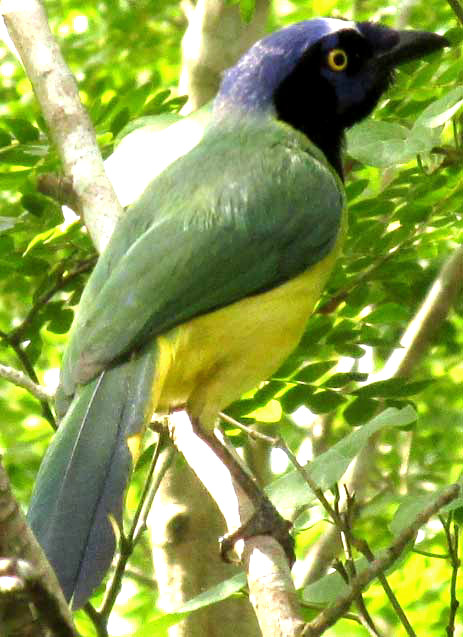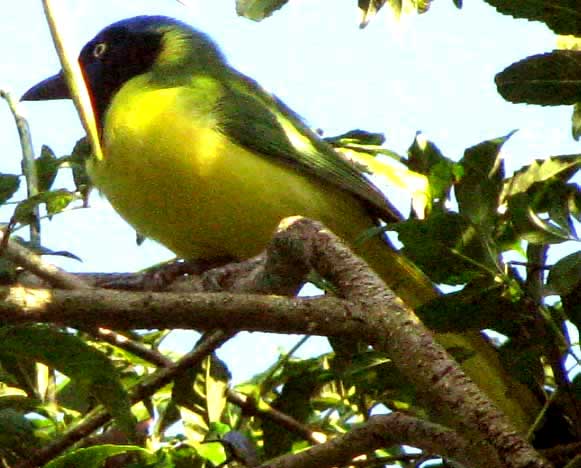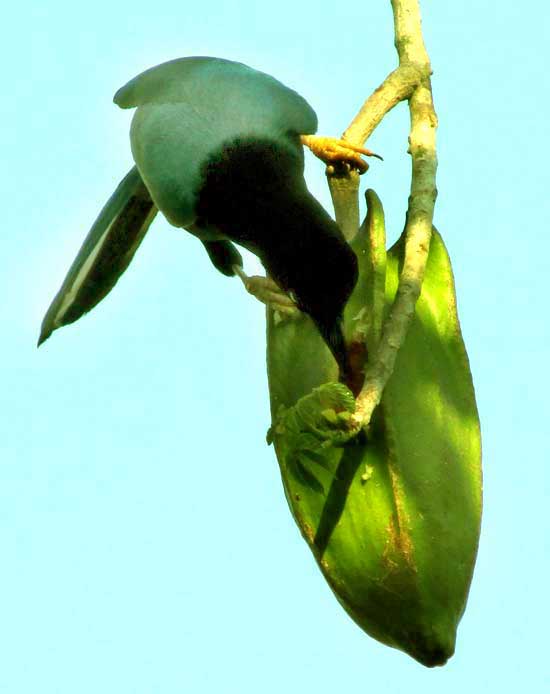Excerpts from Jim Conrad's
Naturalist Newsletter
from the June 7, 2018 Newsletter issued from Rancho Regenesis in the woods ±4kms west of Ek Balam Ruins; elevation ~40m (~130 ft), N~20.876°, W~88.170°, central Yucatán, MÉXICO
GREEN JAY PORTRAIT
Below we have some nice Green Jay pictures, but in each image the bird is twisted around so that the head's handsome blue markings aren't visible. This week a Green Jay came up right beside me as I read on the hut's porch, affording the nice shot appearing below:

from the November 1, 2005 Newsletter written at Hacienda San Juan Lizarraga one kilometer east of Telchac Pueblo, Yucatán, MÉXICO, and issued from Hotel Reef Yucatan 13 kms to the north
GREEN JAYS

On my first trip into Mexico, hitching south on Mexico 85 from Laredo back in the 60s, I think the bird I most wanted to see was the Green Jay, CYANOCORAX YNCAS. I knew that jays were supposed to be blue, so the very name "Green Jay" struck me as heresy, and at that time in my life I was hungry for any heresy that came along. I vividly recall standing on the road with my backpack on, looking into a shadowy, weedy coffee plantation in the state of San Luis Potosi, just awestruck by my first spotting. Maybe that was the very moment I really got hooked on the tropics and its kinky way of throwing us Northerners for a loop.
Black bill, face, throat and chest, blue crown and nape, greenish blue tail with yellow outer feathers, bright yellow eyes, underparts and a truly green back and wings... That's what I saw this week in shadowy, weedy scrub along the road as a Green Jay again and again slammed a very fuzzy, white caterpillar onto a tree limb softening him up, while a second jay watched. When the watcher saw me she screamed a somewhat jaylike ahrrrrrrrrrr and the two flew into the shadows.
Green Jays are slightly smaller than Blue Jays. There are two main populations of them, one extending from southern Texas through Mexico to Honduras, and the other in South America, from Columbia to Bolivia. There must be a good story explaining why Green Jays are absent from Nicaragua to Panama, for good habitat for them is certainly available there
from the May 29, 2016 Newsletter issued from Hacienda Chichen Resort beside Chichén Itzá Ruins, central Yucatán MÉXICO
GREEN JAY EATING JACARATIA FRUIT
Behind the hut, both the Spanish Plum and the Jacaratia -- what the Maya call Bonete -- are producing ripe fruit, which birds eat before I can. You can see a Green Jay feeding on a Jacaratia fruit below:

Green Jays are common throughout most of Mexico's humid lowlands, even north into southern Texas. However, up in Texas the Green Jays' eyes are brown, while here in the Yucatan they're definitely yellow, as in the picture.
Jacaratias belong to the Payapa Family and their mature fruit tastes a bit like papaya. Our page for it is at www.backyardnature.net/yucatan/jacarati.htm
On that page I theorize that the "fins" atop the Jacaratia fruit enable birds, bats and other fruit lovers to more securely hang onto the fruit as they feed on it below them. Our Green Jay has at least one foot on a fin as he reaches down to probe the hole that sometimes also serves other birds, especially White-fronted Parrots.